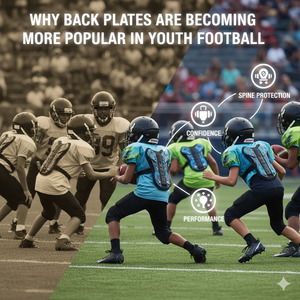Why Back Plates Are Becoming More Popular in Youth Football
Body
Youth football has always been a sport where protection and performance go hand in hand. Parents, coaches, and athletes are constantly searching for the best gear to keep players safe while still allowing them to perform at their peak. In recent years, one piece of equipment that has gained more attention than ever before is the back plate. Once considered an accessory mainly for older or elite athletes, the back plate is now becoming a common sight in youth football across the country. This shift highlights not only the growing emphasis on player safety but also the influence of modern football culture and technology.
The Rise of Back Plate Football Gear in Youth Leagues
Traditionally, a back plate football accessory was associated with professional or college athletes who faced the hardest hits. Today, youth leagues are adopting this gear at a much faster pace. The back plate attaches to the bottom of the shoulder pads and provides critical protection to the lower back and spine. With the intensity of football increasing even at the youth level, many parents and coaches view the back plate as an essential addition to a player’s equipment.
The growing popularity can also be linked to the fact that younger players often mimic the pros they see on television. As NFL and college stars showcase custom back plates, youth athletes are eager to follow suit. It is no longer just about function; it’s also about identity and confidence on the field.
Why a Back Plate Matters for Young Athletes
One of the main reasons parents are investing in a back plate football accessory for their children is safety. Football is a high-contact sport, and even with helmets and shoulder pads, vulnerable areas like the lower back and kidneys remain exposed. A back plate helps absorb the shock from big hits, reducing the risk of injury and giving players peace of mind when they take the field.
Confidence is another major factor. When athletes feel protected, they play harder and with less hesitation. This boost in performance can make a noticeable difference, especially for positions like running backs and wide receivers, who often take heavy hits in open-field situations. The back plate acts as both a physical shield and a mental advantage.
The Connection Between Back Plates and Other Gear
The popularity of back plates in youth football is also tied to the broader evolution of football gear. Just like battle football gloves have become almost standard for enhancing grip and ball control, back plates are now seen as part of a complete protection system. Gloves give athletes sticky hands for better catches, while the back plate ensures that no painful blow to the lower back takes them out of the game.
The synergy between gloves and back plates highlights how youth football is evolving. Athletes no longer settle for the basics; they want specialized equipment that helps them excel in their positions while minimizing risks. This cultural shift has driven a new market where back plate football gear is just as important as cleats or gloves.
Style Meets Protection
Beyond safety, one of the big reasons back plates are popular among younger athletes is the style factor. Many companies now offer customizable designs, bright colors, and bold graphics on back plates. For youth players, expressing individuality through gear is a big part of the game. Just like battle football gloves come in eye-catching designs, back plates allow kids to show personality while staying protected.
This balance between function and fashion makes the gear more appealing. For many young athletes, wearing a back plate isn’t just about safety; it’s about looking like a serious player. Coaches have even noted that players who feel good in their gear often show higher energy and focus during practice and games.
Are Back Plates Necessary for Every Position?
Not every position in football requires a back plate, but the trend is spreading across more roles than before. Skill position players, such as wide receivers, running backs, and defensive backs, tend to benefit the most because they are often hit from behind or blindsided. However, even linemen and quarterbacks are starting to use them as the game gets faster and harder.
For parents deciding whether to buy one, the question often comes down to balancing cost, need, and safety. Considering the relatively low price of most youth back plates compared to other gear, many believe the investment is worthwhile.
The Future of Back Plate Football Gear
The future looks bright for back plates in youth football. With technology advancing, manufacturers are creating lighter, stronger, and more flexible designs. Some companies are even experimenting with smart gear that tracks impact forces, meaning tomorrow’s back plate could provide not only protection but also valuable data for coaches and parents.
Much like the way battle football gloves became a staple in nearly every locker room, the back plate is on track to be a must-have accessory for serious players at every level. The combination of safety, style, and performance makes it unlikely that this trend will slow down anytime soon.
Final Thoughts
The growing popularity of the back plate in youth football represents a significant cultural and practical shift in the sport. It’s no longer viewed as optional; for many parents and athletes, it’s an essential piece of gear. Whether it’s reducing injuries, boosting confidence, or simply giving young athletes a way to look and feel like their idols, the back plate has carved out its place in modern football.
Just as battle football gloves transformed the way players handle the ball, back plates are changing the way youth athletes approach protection and performance. With safety always a top concern in football, the rise of back plate football gear is a welcome evolution that ensures the next generation of athletes can enjoy the game with confidence and security.






Comments